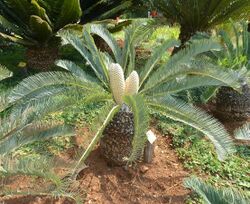Biology:Encephalartos lanatus
| Encephalartos lanatus | |
|---|---|

| |
| Olifants river cycad | |
| Scientific classification | |
| Kingdom: | Plantae |
| Clade: | Tracheophytes |
| Clade: | Gymnospermae |
| Division: | Cycadophyta |
| Class: | Cycadopsida |
| Order: | Cycadales |
| Family: | Zamiaceae |
| Genus: | Encephalartos |
| Species: | E. lanatus
|
| Binomial name | |
| Encephalartos lanatus Stapf & Burtt Davy, 1926
| |
Encephalartos lanatus (Olifants River cycad) is a species of cycad, a plant belonging to the family Zamiaceae growing in Mpumalanga, South Africa . Its specific epithet, lanatus, means wooly in Latin.
Description
This plant is a tall, branching tree with a stem that can reach 1-1.5 meters in height and 25-35 centimeters in diameter. Its leaves are bluish-green, almost silvery, and measure around 100 centimeters in length. They have a thick coating, which gives the plant its specific name. The yellowish spines are straight, with the upper part curved, and the leaflets, which are 10-14 centimeters long, are arranged oppositely along the spine with almost horizontal insertion angles. The margins of the leaflets are smooth and full, with the basal ones being smaller and often reduced to thorns.
This species has male and female cones that are red and shaped like ovoids, measuring 25-30 centimeters long and 5-6 centimeters wide. The female cones are of the same shape but have a diameter of 12-15 centimeters. Each cone is supported by a 2-3 centimeter long peduncle, and each plant can produce between one and four cones.
The seeds are oval or oblong, measuring 25-30 millimeters in length, and are covered with a yellow sarcotesta.[3]
Distribution and habitat
This species is widespread in a very limited area of the provinces of Mpumalanga and Gauteng, South Africa, at the Olifants River basin. Its habitat consists of steep rocky slopes covered with prairie, with warm weather in summer and cold in winter when frosts often occur and with an annual precipitation of between 660 and 770 mm. It grows at an altitude of about 1,500 m above mean sea level.
Conservation
The IUCN Red List lists E. lanatus as a near threatened species.[1] Although it is present in a very limited territory, in fact, its population is currently stable. The species is included in Appendix I to the Convention on International Trade in Endangered Species (CITES)[4]
Bibliography
- The Cycads. Timber press. 2002. ISBN 0-88192-522-5.
- Haynes J.L (2011). "World List of Cycads: A Historical Review". in IUCN/SSC Cycad Specialist Group. Archived from the original on 2015-09-23. https://web.archive.org/web/20150923212116/http://www.cycadsg.org/publications/Haynes-Historical-Review-of-World-List-of-Cycads-2012.pdf.
References
- ↑ 1.0 1.1 Donaldson, J.S. (2010). "Encephalartos lanatus". IUCN Red List of Threatened Species 2010: e.T41933A10603740. doi:10.2305/IUCN.UK.2010-3.RLTS.T41933A10603740.en. https://www.iucnredlist.org/species/41933/10603740. Retrieved 12 November 2021.
- ↑ "Appendices | CITES". https://cites.org/eng/app/appendices.php.
- ↑ "Encephalartos lanatus". https://pza.sanbi.org/encephalartos-lanatus.
- ↑ "CITES - Appendices I, II and III". International Environment House. 2011. http://www.cites.org/eng/app/E-Apr27.pdf.
External links
- "Encephalartos lanatus". The Cycad Pages. http://plantnet.rbgsyd.nsw.gov.au/cgi-bin/cycadpg?taxname=Encephalartos+lanatus.
- "Encephalartos lanatus". The Cycad Society of South Africa. http://www.cycadsociety.org/lanatus/lanatus.html.
Wikidata ☰ Q3724978 entry
 |


